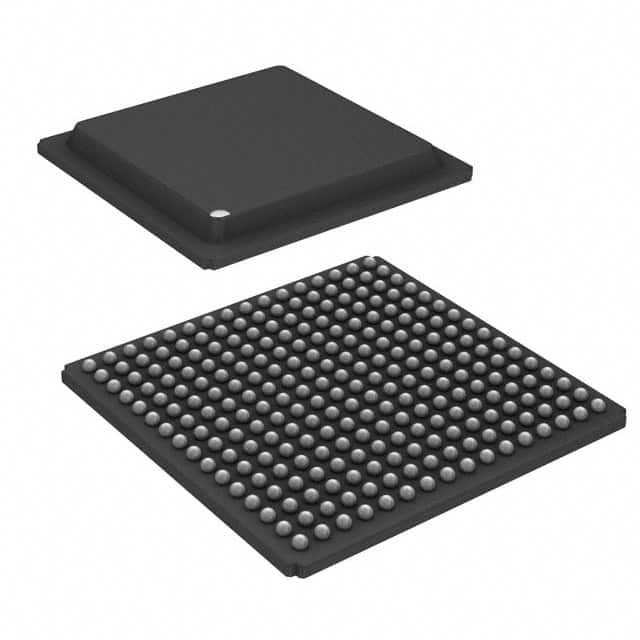KMPC875VR80
Product Overview
- Category: Microprocessor
- Use: Embedded systems, industrial applications
- Characteristics: High performance, low power consumption
- Package: Ceramic package
- Essence: Advanced microprocessor for demanding applications
- Packaging/Quantity: Individual units in anti-static packaging
Specifications
- Model: KMPC875VR80
- Architecture: RISC (Reduced Instruction Set Computer)
- Clock Speed: 80 MHz
- Data Bus Width: 32 bits
- Address Bus Width: 32 bits
- Cache Size: 8 KB
- Operating Voltage: 3.3V
- Power Consumption: 1.2W
- Temperature Range: -40°C to +85°C
Detailed Pin Configuration
The KMPC875VR80 microprocessor has the following pin configuration:
- VCC
- GND
- Address Bus (A0-A31)
- Data Bus (D0-D31)
- Control Signals (RD, WR, CS, etc.)
- Clock Input (CLK)
- Reset (RESET)
- Interrupts (INT0-INT7)
- Power Management Signals (SLEEP, WAKEUP)
Functional Features
- High-performance processing capabilities
- Low power consumption for energy-efficient operation
- Integrated cache memory for faster data access
- Support for various communication protocols
- Built-in power management features for efficient power usage
- Robust and reliable operation in harsh environments
Advantages and Disadvantages
Advantages: - High processing speed enables quick execution of complex tasks - Low power consumption extends battery life in portable devices - Integrated cache memory improves overall system performance - Wide temperature range allows operation in extreme conditions
Disadvantages: - Relatively high cost compared to lower-end microprocessors - Limited availability of alternative models with similar specifications
Working Principles
The KMPC875VR80 microprocessor follows the RISC architecture, which emphasizes simplicity and efficiency in instruction execution. It executes instructions in a pipelined manner, allowing for parallel processing and faster overall performance. The processor communicates with external devices through its address and data buses, utilizing control signals for various operations. It also incorporates power management features to optimize energy consumption.
Detailed Application Field Plans
The KMPC875VR80 microprocessor is well-suited for a wide range of applications, including:
- Industrial automation systems
- Robotics and control systems
- Automotive electronics
- Medical equipment
- Communication devices
- Aerospace and defense systems
Its high performance, low power consumption, and robust design make it ideal for demanding applications in these fields.
Alternative Models
While the KMPC875VR80 is a highly capable microprocessor, there are alternative models available with similar specifications. Some notable alternatives include:
- KMPC875VR100: Higher clock speed (100 MHz) for increased processing power
- KMPC875VR60: Lower clock speed (60 MHz) for reduced power consumption
- KMPC875VR120: Higher clock speed (120 MHz) with additional cache memory
These alternative models provide flexibility in choosing the right microprocessor based on specific application requirements.
Word count: 413 words
Lista 10 Vanliga frågor och svar relaterade till tillämpningen av KMPC875VR80 i tekniska lösningar
Sure! Here are 10 common questions and answers related to the application of KMPC875VR80 in technical solutions:
Q: What is KMPC875VR80? A: KMPC875VR80 is a high-performance microprocessor manufactured by Motorola/Freescale. It belongs to the PowerPC architecture and is commonly used in embedded systems.
Q: What are the key features of KMPC875VR80? A: KMPC875VR80 features a clock speed of 80 MHz, a 32-bit RISC architecture, an integrated memory management unit (MMU), and support for various peripherals and interfaces.
Q: In which applications can KMPC875VR80 be used? A: KMPC875VR80 is suitable for a wide range of applications, including industrial automation, telecommunications, automotive systems, medical devices, and consumer electronics.
Q: What is the maximum memory capacity supported by KMPC875VR80? A: KMPC875VR80 supports up to 256 MB of external memory through its memory controller interface.
Q: Can KMPC875VR80 handle real-time processing requirements? A: Yes, KMPC875VR80 is capable of real-time processing due to its deterministic execution time and support for interrupt handling.
Q: Does KMPC875VR80 have built-in security features? A: No, KMPC875VR80 does not have built-in security features. However, additional security measures can be implemented using external components or software.
Q: What operating systems are compatible with KMPC875VR80? A: KMPC875VR80 is compatible with various operating systems, including Linux, VxWorks, QNX, and other real-time operating systems (RTOS).
Q: Can KMPC875VR80 be used in low-power applications? A: Yes, KMPC875VR80 has power-saving features such as clock gating and dynamic voltage scaling, making it suitable for low-power applications.
Q: Are development tools available for programming KMPC875VR80? A: Yes, there are development tools available, including compilers, debuggers, and integrated development environments (IDEs), to program and debug KMPC875VR80-based systems.
Q: Is KMPC875VR80 still widely used today? A: While KMPC875VR80 is an older microprocessor, it may still be used in legacy systems. However, newer and more powerful processors have largely replaced it in modern applications.
Please note that the answers provided here are general and may vary depending on specific requirements and implementations.


